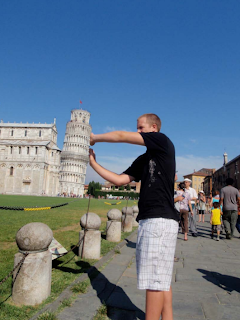50 FACTS ABOUT THE LEANING TOWER OF PISA
1. Construction of Tower began in 1173 under supervision of architect Bonanno Pisano.2. Bell tower was built as manifestation of city’s pride and was meant to reflect rich city of Pisa.
3. Work on Tower ceased in 1178 for reasons unknown; studies have shown that soil on which Tower was built would not have been able to withstand more construction at that time.
4. Construction began again, but ceased in 1278.
5. Had Tower been completed at this time, would have collapsed because of the stress on soil.
6. During actual construction of Tower in 1100’s, Tower originally leaned north
- Masonry blocks placed on each level to correct lean of axis.
7. By end of its construction, the Tower leaned significantly to the South.
8. Tower was finally completed in 1370; height is 53 m.
9. From early 1990 until December 2001, Tower was closed to public because of safety issues.
10. Italian engineers implemented complex $25 million rescue plan in order to stabilize Tower.
11. Although Tower looks as if it might collapse at any moment, in reality, it is more stable now than at any time in past few centuries.
12. In 1838, architect Alessendro della Gherardesca constructed a walkway around Tower base .
13. Water filled the walkway area after the excavation extended below water table.
14. Plan increased tilt of Tower by over one quarter of a degree.
15. Gherardesco placed 0.7 meter thick ring of concrete around walkway to help stabilize Tower, but excavation nearly caused its downfall.
16. In 1934, engineers used grout injection to stabilize the foundation of Tower.
17. This process led to a displacement of Tower.
18. The tip of Tower tilted 10 mm more to South.
19. In 1993, 600 Mg of lead weights were added to north side of Tower, attached by a removable concrete ring placed around base of Tower
- Reduced leaning by nearly one minute of an arc
- Reduced moment that pulled on Tower by 10%.
20. Load was increased in 1995 to 900 Mg while engineers attempted to replace lead weights with ground anchors.
21. One unique idea was to drill 10,000 holes in Tower to significantly reduce its weight.
22. Replica was to be placed next to Tower leaning in opposite direction to hold original tower in place.
23. A new restoration idea was presented in the 1990s
- Known as soil extraction, or soil subsidence
- Its goal was to excavate earth from beneath Tower’s foundation on its northern side so that Tower would tilt back toward perpendicular.
24. Idea was put into motion after various tests on Tower itself and on soil underneath its foundation.
25. Temporary cables attached to 3rd level of Tower
- Would support Tower if anything went wrong during soil extraction.
26. Lead weights were attached to ends of cables to ensure that Tower would remain steady.
27. First soil extraction occurred on February 9, 1999
- Extracted by means of corkscrew drills.
28. At first, Tower showed no sign of rotation, but then rotated toward the North.
29. Tower had rotated seven seconds of an arc toward the North by February 23, 1999, but then it rotated back toward the South
- Occurred as a result of strong, cold winds from the North
- Tower soon began to rotate back toward the North after winds had diminished.
30.Soil extraction was stopped after Tower had rotated a total of eighty seconds of an arc by June 1999.
31. Three of the lead weights were removed in July 1999, and this resulted in a discontinuation of rotation.
32. Main soil extraction began in the year 2000, after preliminary extractions had shown vast improvement.
33. Tower had a tendency to rotate to the East throughout the process, so soil also had to be extracted from foundation’s west side.
34. Tower continued to move northward, and slowly the lead was removed from the structure.
35. Restoration process was finished on June 6, 2001.
36. Tower had returned to position it was in before 1838.
37. Restoration process moved Tower 1,830 seconds of an arc.
38. Design process cost the Italian taxpayers $25 million.
39. Design process was complicated by decree made by Italian Government that needed to be approved regularly by Italian Parliament
- Delayed restoration process
- Work was halted for long periods of time.
40. Restoration process was halted when harsh winds caused Tower to rotate toward the South.
41. Throughout restoration process, Tower had to be closed to tourists
- Tourists had been able to pay a fee so they could climb Tower.
42. Stabilization of Leaning Tower provided difficulties of its own
- Tower was originally constructed on weak, compressible soil, which increased .instability of Tower.
- Ground on south side of Tower had to be treated with delicacy because any .disturbance could result in falling of Tower.
- Original design of Tower had to be respected throughout the process to conserve monument’s character.
43. There are 294 stairs to top of Tower.
44. Leaning Tower weighs about 14,700 metric tons.
45. About three million people visit Tower annually.
46. There are seven bells on Tower, largest of which weighs 3.5 tons.
47. Restoration process was very difficult to execute
- Soil on which Tower was built was very unstable
- Tower’s original design had to be maintained.
48. Soil extraction was a successful process that saved Tower from collapse.
49. Speculation on whether restoration process will be beneficial in future
- Professor Burland, who oversaw the restoration process, believes Tower may stay in its current condition
- Professor Burlandspeculates that Tower may begin rotating again, and in 300 years,
Tower will be where it was in 1990s.
50. Leaning Tower was reopened to public on December 15, 2001.





















0 comments:
Post a Comment